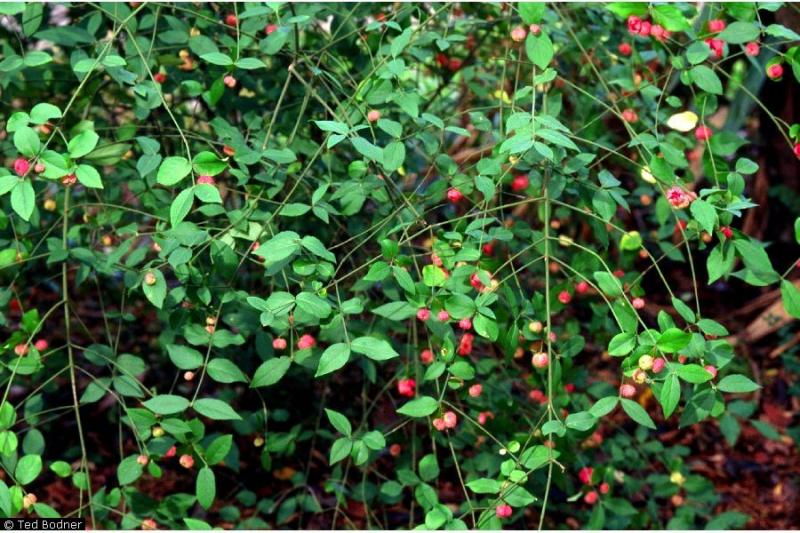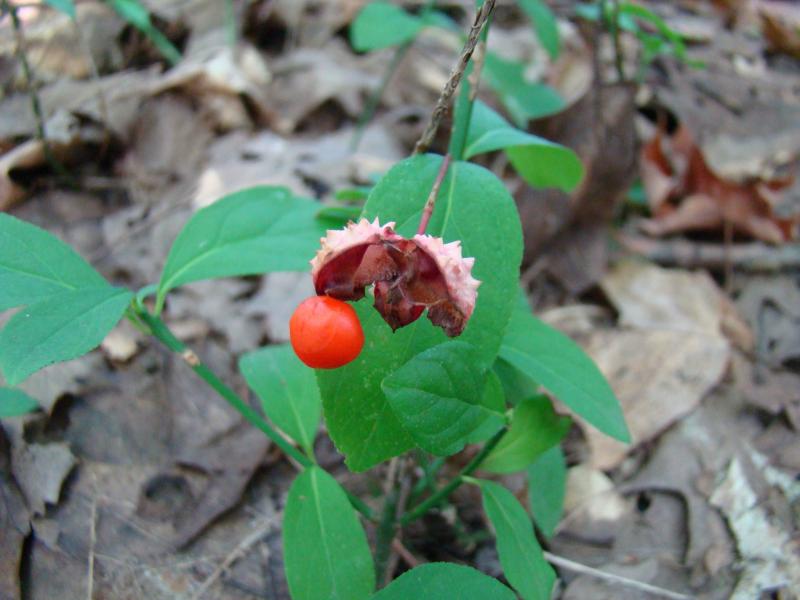American Strawberry Bush
Euonymus americanus L.
- Class
- Dicotyledoneae (Dicots)
- Family
- Celastraceae (Bittersweet Family)
- State Protection
- Endangered
Listed as Endangered by New York State: in imminent danger of extirpation in New York. For animals, taking, importation, transportation, or possession is prohibited, except under license or permit. For plants, removal or damage without the consent of the landowner is prohibited.
- Federal Protection
- Not Listed
- State Conservation Status Rank
- S1
Critically Imperiled in New York - Especially vulnerable to disappearing from New York due to extreme rarity or other factors; typically 5 or fewer populations or locations in New York, very few individuals, very restricted range, very few remaining acres (or miles of stream), and/or very steep declines.
- Global Conservation Status Rank
- G5
Secure globally - Common in the world; widespread and abundant (but may be rare in some parts of its range).
Summary
Did you know?
One of the common names, hearts-a-burstin', comes from the way the orange seeds appear to burst from the red fruit when it is mature. These showy fruits certainly make up for the small drab flowers. Shrubs are readily available in the nursery trade but New York is at the northern end of its range so cultivation may not always be successful.
State Ranking Justification
There are five existing populations but none of them exceed 50 plants. There are 14 records known from the late 1800s through 1928 but six of them are extirpated due to habitat destruction and the other seven have not been resurveyed in detail.
Short-term Trends
Short-term trends seem stable but deer overbrowsing is a new threat that may be decreasing populations.
Long-term Trends
This plant has always been very rare in New York but populations have decreased in the last 100 years because of development in Western Long Island and the New York City area.
Conservation and Management
Threats
All populations exist in small green spaces surrounded by development. These highly-visited areas provide less opportunity for plants to reproduce and thrive. The overabundance of deer is threatening the long term viability of many populations because of persistent overbrowsing.
Conservation Strategies and Management Practices
Plants must be protected from overt human disturbance and existing populations should be augmented. Reduce the deer herd locally or erect deer fencing to protect individual populations.
Research Needs
Research should be undertaken to determine methods of effective propagation to augment existing populations.
Habitat
Habitat
In New York the plants can be found in wet areas of successional southern hardwoods, small old growth red maple/tupelo swamps along streams, red maple swamps, and in wet areas of mixed deciduous beech and sweetgum forest. (New York Natural Heritage Program 1998). Rich woods and ravines (Fernald 1970). Moist woods (Gleason & Cronquist 1991).
Associated Ecological Communities
- Red maple-blackgum swamp
(guide)
A maritime, coastal, or inland hardwood swamp that occurs in poorly drained depressions, sometimes in a narrow band between a stream and upland. Red maple and blackgum are often codominant or blackgum may be the dominant tree. Pitch pine may occur on drier hummock islands in pine barrens settings.
- Red maple-hardwood swamp
(guide)
A hardwood swamp that occurs in poorly drained depressions, usually on inorganic soils. Red maple is usually the most abundant canopy tree, but it can also be codominant with white, green, or black ash; white or slippery elm; yellow birch; and swamp white oak.
- Red maple-sweetgum swamp
(guide)
A hardwood swamp that occurs on somewhat poorly drained seasonally wet flats, usually on somewhat acidic soils. Red maple-sweetgum swamps often occur as a mosaic with upland forest communities. Sweetgum is often the dominant tree or may be codominant with red maple. Other codominant trees include pin oak and blackgum.
- Successional southern hardwoods
A hardwood or mixed forest that occurs on sites that have been cleared or otherwise disturbed. Canopy trees are usually relatively young in age (25-50 years old) and signs of earlier forest disturbance are often evident. Characteristic trees and shrubs include any of the following: American elm, slippery elm, white ash, red maple, box elder, silver maple, sassafras, gray birch, hawthorn, eastern red cedar, and choke-cherry.
Associated Species
- Fagus grandifolia (American beech)
- Liquidambar styraciflua (sweet-gum)
- Magnolia virginiana
- Nyssa sylvatica (black-gum, sour-gum)
- Prunus serotina
- Quercus alba (white oak)
- Quercus rubra (northern red oak)
- Sassafras albidum (sassafras)
- Viburnum acerifolium (maple-leaved viburnum)
Range
New York State Distribution
This shrub is currently known from Staten Island and Nassau County on Long Island but historical records exist north from Queens through the Bronx to Rockland County with a disjunct record in Monroe County near Rochester.
Global Distribution
This is a species of the Southeastern United States. It ranges from Florida to East Texas, north to Arkansas and east to New Jersey. Its northern limits skirt the southern counties of Missouri, Illnois, Indiana, and Ohio. Its northeastern limit reaches a handful of counties in Pennsylvania and New York where it is rare.
Identification Comments
General Description
This is an erect shrub with stiffly divergent branches. The uppermost leaves are lanceolate to ovate with petioles 1-5 mm long. The small flowers have 5 sepals and 5 greenish-purple petals that are narrowed at the base. The crimson fruit has 3-5 lobes and is covered in little projections (tuberculate).
Identifying Characteristics
Distinguishing characteristics: Erect shrub with stiffly divergent branches; uppermost leaves lanceolate to ovate; petioles 1-5 mm long; flowers 5-merous. Best life stage for ID: in fruit or flower. Characteristics needed to ID: may be identified vegetatively.
Best Life Stage for Proper Identification
The best time to identify the plant is when it is in flower or fruit although it may be identified in leaf only.
Similar Species
Euonymus alatus has a winged stem and a 4-merous flower. E. obovatus is a trailing shrub, possibly with a few ascending branches and obovate uppermost leaves.
Best Time to See
Vegetative shoots start growing March through April, flowering begins early May and last until mid-July, fruits persist to mid-November.
- Vegetative
- Flowering
- Fruiting
The time of year you would expect to find American Strawberry Bush vegetative, flowering, and fruiting in New York.
American Strawberry Bush Images
Images of Similar Species
Taxonomy
American Strawberry Bush
Euonymus americanus L.
- Kingdom Plantae
- Phylum Anthophyta
- Class Dicotyledoneae
(Dicots)
- Order Celastrales
- Family Celastraceae (Bittersweet Family)
- Order Celastrales
- Class Dicotyledoneae
(Dicots)
- Phylum Anthophyta
Additional Common Names
- Bursting-heart
- Hearts-a-bursting
- Hearts-a-bursting-with-love
- Strawberry-bush
Additional Resources
Best Identification Reference
Gleason, Henry A. and A. Cronquist. 1991. Manual of Vascular Plants of Northeastern United States and Adjacent Canada. The New York Botanical Garden, Bronx, New York. 910 pp.
Other References
Fernald, M.L. 1950. Gray's manual of botany. 8th edition. D. Van Nostrand, New York. 1632 pp.
Holmgren, Noel. 1998. The Illustrated Companion to Gleason and Cronquist's Manual. Illustrations of the Vascular Plants of Northeastern United States and Adjacent Canada. The New York Botanical Garden, Bronx, New York.
New York Natural Heritage Program. 2010. Biotics database. New York Natural Heritage Program. New York State Department of Environmental Conservation. Albany, NY.
New York Natural Heritage Program. 2024. New York Natural Heritage Program Databases. Albany, NY.
Newcomb, Lawrence. 1977. Newcomb's Wildflower Guide: An Ingenious New Key System for Quick, Positive Field Identification of the Wildflowers, Flowering Shrubs, and Vines of Northeastern and North-Central North America. Little, Brown and Company. Boston.
Weldy, T. and D. Werier. 2010. New York flora atlas. [S.M. Landry, K.N. Campbell, and L.D. Mabe (original application development), Florida Center for Community Design and Research http://www.fccdr.usf.edu/. University of South Florida http://www.usf.edu/]. New York Flora Association http://newyork.plantatlas.usf.edu/, Albany, New York
Links
About This Guide
This guide was authored by: Stephen M. Young
Information for this guide was last updated on: September 20, 2012
Please cite this page as:
New York Natural Heritage Program. 2024.
Online Conservation Guide for
Euonymus americanus.
Available from: https://guides.nynhp.org/american-strawberry-bush/.
Accessed July 26, 2024.

